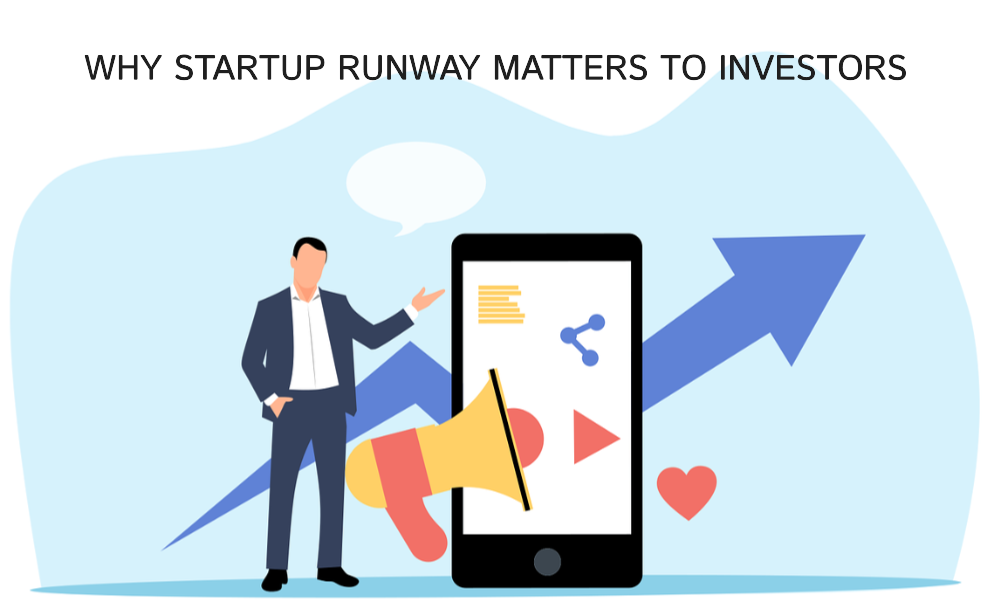Why startup runway matters to investors? That’s a question every entrepreneur must ask themselves before they set out to raise funding. You’ll place yourself in the investor’s shoes to understand their perspective when evaluating a startup. What do they look for? What are the red flags they’ll identify?
Answers to these questions will help you design a compelling pitch deck that addresses their crucial concerns. Understandably, you’ve done the math. You know exactly how many months of operating capital you have available. That’s why you consider this the right time to raise capital.
But, how will investors view this key metric? And, what do you need to know about calculating it? Let’s dive in and find out.

*FREE DOWNLOAD*
The Ultimate Guide To Pitch Decks
What Exactly is Startup Runway?
Let’s be sure we’re on the same page and you understand exactly what is a startup runway. Also called cash runway, startup runway is the time interval your company can continue operating before it runs out of money. That is, assuming you have no additional capital sources lined up.
Statistics indicate that around 21% of startups fail within the first year and 30% fail in their first two years. Eventually, just 30% will make it beyond the 10-year mark. Regardless of the capital they had when starting out, close to 38% of companies go under because of cash flow issues.
Either these startups run out of money to continue operating or they are unable to raise funding. Why startup runway matters to investors when a capital injection can solve their cash issues? If that’s what you’re thinking, know that 75% of companies raising venture capital fail to return it.
This incredible failure rate results in investors scrutinizing the runway carefully. They’ll also examine the core factors influencing a company’s cash flow to identify its potential to overcome challenges. Runway represents financial health and its ability to generate profits without raising capital.
Calculating Startup Runway
To calculate the startup’s runway, you’ll start by adding up the current cash reserves. Next, you’ll divide this number by the burn rate or the expenses you incur to sustain operations. A higher number represents a long runway, which means you have adequate funds to continue operating.
Accordingly, let’s assume you have $200,000 in the bank and the total monthly expenses are $20,000. Dividing $200,000 by $20,000 gives you 10 months of runway. If the company starts generating consistent revenues during this interval, it will, undoubtedly, extend the runway.

Raise Capital Smarter, Not Harder
- AI Investor Matching: Get instantly connected with the right investors
- Pitch & Financial Model Tools: Sharpen your story with battle-tested frameworks
- Proven Results: Founders are closing 3× faster using StartupFundraising.com
Factor in Fundraising Time
It is crucial to understand that raising funding is a time-consuming process. Several factors can influence how quickly you can get investors on board. This is why your fundraising consultant will advise you to start a fundraiser at least six months before you expect to run out of operating cash.
For starters, you can safely assume that running a campaign and closing the round will take around four months. Also, estimate that creating a pitch deck, a business plan, and compiling financial statements will take another 30 days. You’ll also set up and add details to the data room in this time.
It is always advisable to plan for an added 30 days of runway before you finally get money in the bank. This estimated duration is for the pre-seed stage, when most founders are developing their business idea. They need only a small amount of initial funding to transform that idea into a product.
When estimating how much funding to raise, work out the amount of capital you’ll need to reach the next milestones. For instance, building the Minimum Viable Product (MVP), acquiring contracts, or catering to a specific number of subscribers.
Accordingly, having successfully secured funding, you should have an adequate runway of 18 to 24 months. The capital should allow the company to continue operating through this duration and possibly longer.
Keep in mind that every fundraising campaign deflects attention from the actual running of the company. You want to avoid that since you’ll need to direct your energies and bandwidth toward building the company.
Why Startup Runway Matters to Investors
This is the interval that investors will focus on when evaluating your pitch for the next round. They will examine the Key Performance Indicators (KPIs) you committed to in the earlier pitch. Were you able to execute on the plan successfully? Did you achieve the milestones as projected in the pitch deck?
These are questions investors ask. Achieving your goals indicates that your startup has a robust business plan and concept. You’ll also demonstrate reliability and trustworthiness since you can stand by your commitments.
A decent runway reassures investors of your business acumen and expertise with managing startups. Founders who have successfully built a venture have a higher probability of success with their next startups. So, as an entrepreneur, your track record is also under scrutiny.
Financial Strategy
A robust runway indicates the company has adequate cash reserves and anticipates incoming revenues. It also shows sound financial management and that the company can efficiently handle its costs and expenses.
Investors note that the burn rate is low and that you’ll allocate resources strategically to derive maximum value. Practical budgeting approaches, negotiation tactics for economical inventory and services from vendors, and other cost-cutting measures impress investors.
A company that isn’t at an immediate risk of running out of money is always more attractive to investors. They recognize that the company’s finances are strategically planned to continue operating without an urgent cash infusion.
Keep in mind that storytelling is everything in fundraising. In this regard, for a winning pitch deck to help you here, take a look at the template created by Silicon Valley legend, Peter Thiel (see it here) that I recently covered. Thiel was the first angel investor in Facebook with a $500K check that turned into more than $1 billion in cash.
Remember to unlock the pitch deck template that founders worldwide are using to raise millions below.
Potential for Growth
A company with a longer runway and adequate cash reserves will take time to develop growth strategies. You’ll allocate resources toward research and development to expand your product portfolio or develop improved versions with better features.
You’ll experiment with innovations and new business models without the pressure to raise capital. You’ll also look into expansion strategies to capture new markets and target a broader customer base.
Hiring fresh talent for the team and strengthening the company’s internal infrastructure are other areas you can focus on. An extended runway enables startups to divert time and bandwidth toward growth. Investors recognize this factor, which is why growth potential is high on their list of criteria.
Understand that a company with a shorter runway is under intense pressure to accelerate growth. The need to generate revenues quickly may result in premature product releases that fail to capture audience interest.
Companies may end up compromising on quality and the product falling short of expectations. New brands often find it harder to recover from this initial setback and the competition quickly overtakes them.
Resilience Against Risks
Why startup runway matters to investors has much to do with the risk factor. A longer runway means the company is stable and better equipped to deal with unexpected fluctuations or market downtrends. Its reserves will see it through unforeseen challenges that may arise.
Before investing in a startup, investors examine the risk propensity and a stronger company is worth backing.
Fundraising Strategy
An extended runway demonstrates sound planning when it comes to fundraising strategies. If you’ve raised a seed funding round, you should have adequate capital to sustain the company until the next. The company should be able to generate adequate revenues and profits by using the resources.
This is why startup runway matters to investors. They need assurance that the funds they invested will bring them returns. The Use of Funds slide in your pitch deck will give them the necessary information. It will tell them how you intend to deploy the new capital and earn profits.
An extended runway places the company in a better position when negotiating funding terms and conditions. Since you’ll take your time scouting around for competitive term sheets, you’ll select capital sources that will involve minimum dilution.
You’ll also look for investors open to offering capital at lower interest rates and more favorable conditions. The lack of urgency works in your favor.
Remember to factor in the fundraising costs, which can add up substantially. Your company should have the cash reserves to approach investors and get money in the bank.
Adaptability and the Ability to Pivot if Necessary
Venture capital is expensive in the current economic atmosphere, which is why investors are cautious about the companies they back. Although profitability is high on their list of priorities, they also need to see that the company is agile.
The present-day startup ecosystem is dynamic with new innovations arriving on the scene regularly. Customer needs, buying habits, and expectations are also changing quickly. A company has a higher probability of stability and long-term success if it can quickly recognize and adapt to trends.
Pivoting is not a bad strategy, but it demonstrates that the company is committed to product-market fit. Companies with a longer runway have the resources to adapt. They can integrate innovations quickly and develop new features or entire product portfolios, which investors consider a green flag.
Industry-Specific Runway
Not all sectors are alike and some industries are more volatile than others. Historically, crypto, tech, healthcare, energy, and finance sectors experience more uncertainty. As a result, investors are more cautious when offering capital. You’ll work harder to attract investors if you work in these verticals.
Since these industries are also capital-intensive, the company’s runway is under closer scrutiny. You’ll operate more efficiently, keeping a close watch on your expenses. Any decisions you make should be result-oriented and focused on quickly raking in revenues while protecting cash reserves.
Now that you have an overview of one of the facets investors consider, let’s move on to the next step. Check out this video in which I have talked about how to put together an investor outreach strategy. In it, you’ll find information about the company’s runway and several other effective tips.
How to Extend the Company’s Runway
Entrepreneurs should understand that building an extended runway is not just about attracting investors. It’s also about ensuring the company’s stability, efficient cash management, and long-term success. Whatever strategies you adopt will appear as green flags during the due diligence phase.
Here’s what you can do to ensure a longer runway and self-reliance.
- Identify new revenue sources and strategies which will bring in much-needed cash. For instance, explore your pricing and business models for the possibility of discounted deals that can promote sales. When offering discounts, stress on the product’s value proposition.
- Research competitor pricing strategies and devise limited-period offers to convert buyers. Leverage the FOMO approach to entice customers. Also, consider offering discounts for referring friends and family to the brand.
- Experiment with the recurring revenue subscription model to build steady cash inflow streams.
- Enter into horizontal partnerships with companies and brands offering complementing products and services. Offering package deals during specific times of the year could entice customers to finalize purchases. For instance, the Holidays, Thanksgiving, Christmas, and Easter.
- Scrutinize the costs and expenses and work out methods for reducing them. Negotiate with vendors and suppliers for discounts and longer credit periods. Also work with your distributors and logistics providers for more favorable pricing. Bulk orders always work to your advantage.
- Don’t expand the team unless absolutely essential. The team slide and the talent and skill sets you have on board undoubtedly enhance your pitch deck. But strike a balance between ensuring company growth and increasing human resource expenses.
- Streamline your payment collection policies by setting up efficient collection procedures. Set up email reminder schedules and train team members in effective communication when interacting with clients. Make sure customers understand payment terms and conditions when placing orders. Be sure to enforce the rules.
In Conclusion
Every entrepeneur should keep a close watch on the company’s burn rate and cash inflows. This strategy is crucial for ensuring the company is stable and will continue operating without external funding. But, you should also understand why startup runway matters to investors.
Both entrepreneurs and investors view the metrics and runway length as signs of the company’s potential for growth and profitability. Investors see the company as a good candidate for investing capital since it can grow quickly.
They need assurance that their investment is secure and will generate returns. Thus, a company that demonstrates a longer runway is more likely to be successful when securing funding. So, work on improving cash flows by cutting back on expenses and raising revenues.
You may find our free library of business templates interesting as well. There, you will find every single template you will need when building and scaling your business completely for free. See it here.





Facebook Comments